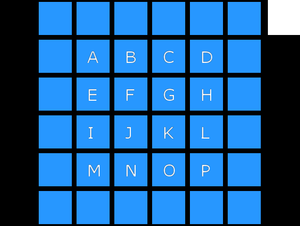Talk:Stimulus tagging using aperiodic visual stimulation in a VEP-based BCI
The following section will be added to the public page
Video output
VEP Flasher
In order to have a working VEP stimulation grid we wrote this piece of software, which we called VEP Flasher. It can display different kinds of visual stimuli on a normal LCD or CRT screen with a precise frame rate, equal to the refresh rate of the screen.
Stimuli are represented on the screen by rectangles that change their colour over time accordingly with an input source, with an optional text inside. Input sources can be sine or square waves, constants or numeric vectors loaded from text files. More can be added, thanks to the flexible software architecture.
See also VEP Flasher reference manual.
Source package: to do
Binary package for MS Windows: to do
Stimulation grid design
The screen displays 16 symbols, each with a different flashing pattern. Actually, we used the same sequence (a periodic binary pseudo-random white noise) for all symbols, each with a different time shift. We chose a sequence with a very low autocorrelation (except with a null lag) so that the 16 symbols would minimally interfere with each other.
The synchronisation pattern (a square wave whose rising front marks the beginning of every period) is located in the upper-right corner. It is hidden to the patient by putting a black carton patch between the corner of the screen and the patient. In front of the screen a light sensor, connected to the EEG amplifier, records this synchronisation signal. The classifier will use it to split every recording into periods.
Because the fovea is the most sensitive area of the retina, the object that is at the centre of the visual field will cause a stronger reaction in the visual cortex than the same object in another position. We will assume that the objects outside the scope of the fovea will cause little interference, and that therefore the cortical reaction to every stimulus will be the same, when time-shifted appropriately. The reaction to a periodic stimulus (the pseudo-white binary noise, which is a sequence 1 to 2 seconds long repeated several times) will be assumed as periodic as well. The problem of classifying a stimulus is then reduced to the easier problem of evaluating the lag between a periodic time series and a noisy, time-shifted version of it.
